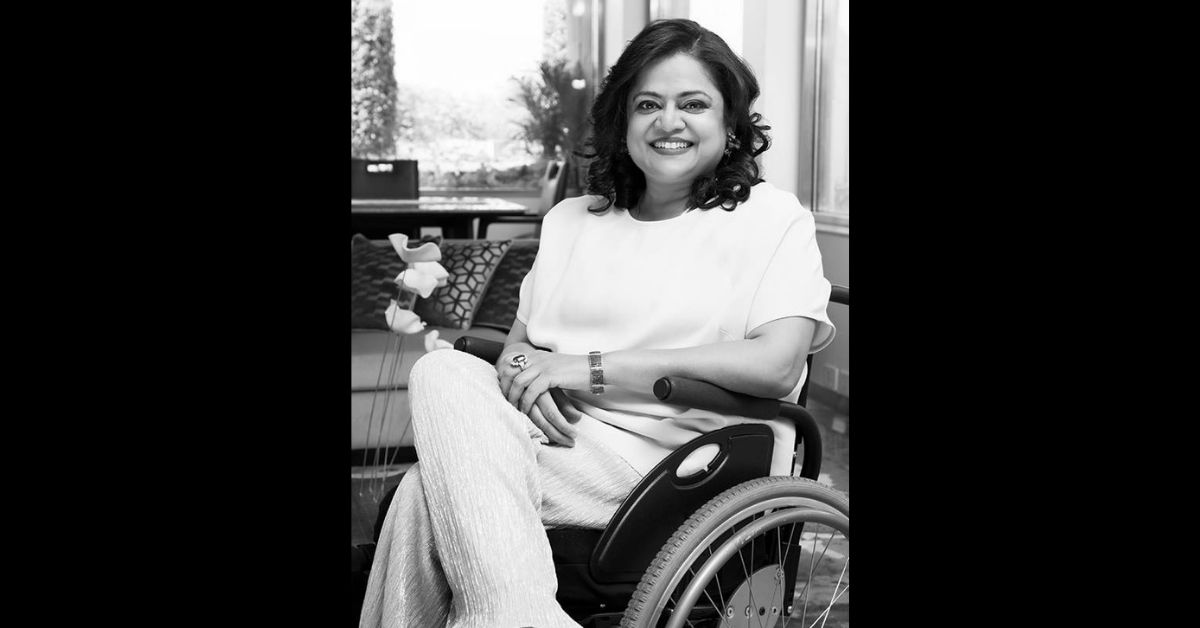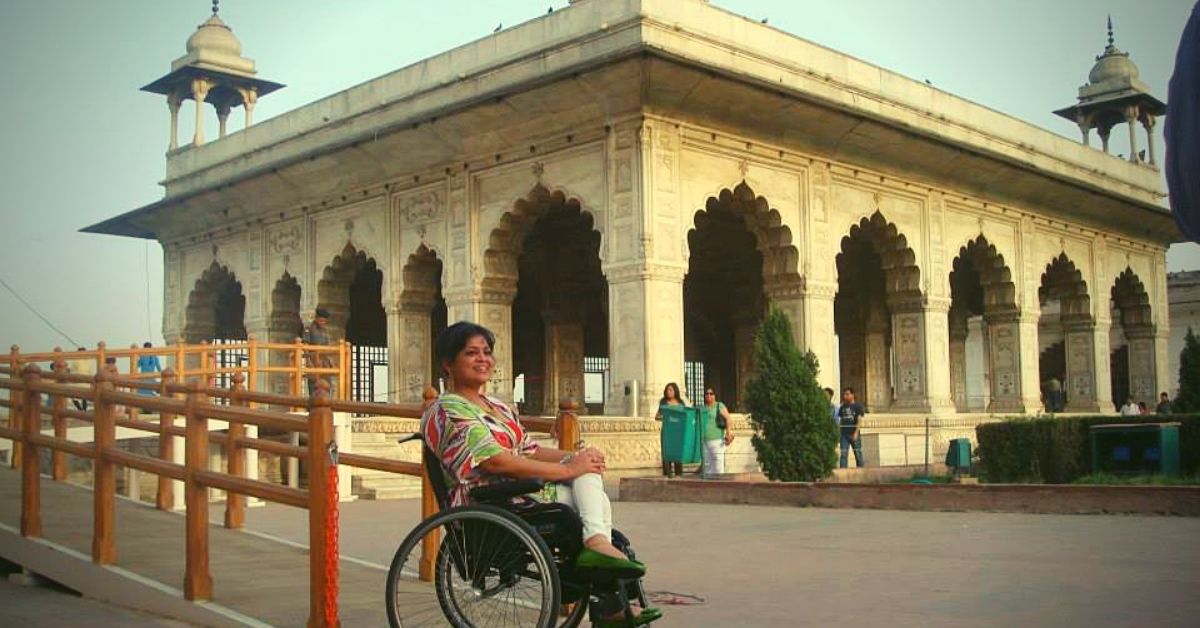“Can you imagine not being able to step out of your house for almost 10 years?” asks Sminu Jindal, one of the most prominent names in the steel, oil and gas industry of India.
What might seem like a paradoxical statement here is indeed the truth and a compelling saga of a woman who fought all obstacles to rise to prominence.
Empowerment can come in various shapes and forms. But, what remains constant is the idea to extend a sense of understanding and support, to enable someone be their best. Check out, how you can help empower someone, here.
The Managing Director of Jindal SAW Ltd is not just the first woman in India to break into a highly male-dominated sector as a leader, but a roaring voice who has dedicated her entire life towards advocating the need for accessibility in India and beyond.
Her life’s purpose, in her words, is to create, ‘a barrier-free India where a person, no matter what status, age, condition or disability, can live with dignity and independence, travel safely and walk safely with equal ease.’

Owing to this idea, she founded Svayam, Global Centre for Inclusive Environments, in
2000. As an initiative of the Sminu Jindal Charitable Trust (SJCT), the Delhi-based organisation, has dedicated all these years educating people and the government to create a truly inclusive world, where those with reduced mobility can travel without any worry.
Focused on making Indian tourism accessible and inclusive, the organisation has made remarkable feats in the last 19 years.
The beginning
Jindal was an 11-year-old, and returning home to Delhi from her boarding school in Jaipur when her car met with an accident. The accident caused a severe spinal cord injury, owing to which she became a wheelchair user for the rest of her life.
“While it took me a long time to come to terms and realise what had happened to me, I was lucky enough to have amazing parents who stood by me, and ensured that my education did not suffer. I joined a regular school, but was constantly under supervision and missed my earlier independence” says Jindal, who prior to the accident, was a talented Kathak dancer who had received distinction at the Bharatiya Kala Kendra, at the age of nine.
The years eventually rolled by, and it was time for another big step: college.
“At the time, the idea of accessibility was so unheard of that schools and colleges would not have the needed provisions at all. So, when I joined college, my father got a ramp made for me, and that got me thinking about other people like me, who were not as fortunate. I needed to do something to empower them because accessibility is the first step towards inclusion,” she says.
Over the years, this idea only grew stronger.
“It is surprising how I had never come across anybody like me—not in school and not even in college. At the time, it made me feel like I was the only one, but only later I realised that the situation was like that because of the lack of facilities, that stopped people with reduced mobility to move around with the freedom they deserve!” says Jindal, who began to work for the cause alongside shaping her career.
Svayam- a path to self-empowerment
“People with reduced mobility are one of the most marginalised communities in the country due to lack of accessibility in our infrastructure. As our homes, public offices and transport systems are not accessible; people with reduced mobility are not able to access employment opportunities. They are forced to remain caged in their homes, leading a life of despair,” says Jindal, whose organisation, Svayam aims to find solutions to this problem, by focusing on inclusive mobility, accessibility in infrastructure and transportation systems and services.
Through awareness, access audits, capacity building and policy intervention, Svayam has been driving change all across the country since 2000.
In 2007, Svayam held its first workshop at the Ministry of Tourism to sensitise senior tourism officials of different states, and Jindal recalls that the then Secretary of Tourism decided to stop the release of central funds for tourism projects unless accessible infrastructure is not incorporated in it.
It was one of the first prominent wins for Svayam, which opened up a bigger avenue to see and advocate accessibility from a business point of view.
“Today, we see more people with disabilities visiting hotels, restaurants and taking parts in various activities, including sports. However, to make accessible tourism a reality, we have to ensure that the entire trip chain from the airports to railways, buses, taxis, hotels, hospitals, shopping areas, tourist attractions and sites are accessible,” says Jindal.
Svayam is now a member of the Standing Committee on Accessible Transport & Mobility of the Transportation Research Board (TRB) of the National Academies, USA, and has been working with the Indian Railways, Delhi Metro, Civil Aviation Ministry, Delhi Transport Corporation, to make accessible transportation a reality in India.
Landmark Feats
Back in 2008, Svayam created history by making the first-ever World Heritage Site truly accessible.
Svayam along with the Archaeological Survey of India (ASI) revamped the famous Qutub Minar, a UNESCO World Heritage site, to be a genuinely inclusive space that welcomes all.
The project earned several accolades, and consequently, Svayam became the first organisation to be conferred with the National Tourism Award for Excellence, and it was jointly received by the Archaeological Survey of India (ASI).
However, the Qutub Minar was just the beginning, as the trail of success followed to various other heritage sites, including the Taj Mahal, Red Fort and Fatehpur Sikri.
The next landmark step for the organisation was to drive the Accessible India Campaign (AIC) as one of the biggest contributors under the Government of India.
Under the AIC, Svayam alone won the contract for audits of 340 buildings across eight cities in India—New Delhi, Mumbai, Varanasi, Chandigarh, Gurgaon, Faridabad, Jaipur and Dehradun.
This was further extended on 20 June 2018, when a Memorandum of Understanding (MoU) was signed between Svayam and the Delhi International Airport Limited (DIAL), to improve the accessibility for persons with reduced mobility (PRM) at all existing and future IGI projects.
Since then, they have been conducting access audits of the IGI Airport, and impart sensitisation training to airport staff, vendors, etc.
Over the years, while Svayam has had a train of such impactful initiatives, the recent one was in collaboration with the Election Commission of India (ECI) to make the General Election 2019 inclusive.
“On 15 August 2019, the Hon’ble PM, from the ramparts of the Red Fort, called upon every citizen to visit at least 15 domestic tourist destinations across India before 2022 to promote tourism in the country. This is a wonderful thought. However, we believe that accessibility can be a game-changer here. By developing making tourism attractions more accessible you suddenly open them up to a large section of society. If more people visit tourist places, facilities out there will improve,” adds Jindal.
A true hero of sorts, Sminu Jindal’s exemplary work has impacted thousands of individuals, not only those with physical disabilities.
Elaborating on this, she concludes, “People usually tend to push these things off as something secondary, as they think it doesn’t affect them personally. But, accessibility is not important just for the differently-abled. It is useful for anybody, be it an elderly individual or a pregnant woman or an injured person. The idea is to create a truly barrier-free India, in all respects.”
Also Read: He Learnt Swimming In Floods. Today, This Paraplegic Champion Owns a World Record!
(Edited by Gayatri Mishra)
Like this story? Or have something to share?
Write to us: contact@thebetterindia.com
Connect with us on Facebook and Twitter
If you found our stories insightful, informative, or even just enjoyable, we invite you to consider making a voluntary payment to support the work we do at The Better India. Your contribution helps us continue producing quality content that educates, inspires, and drives positive change.
Choose one of the payment options below for your contribution-
By paying for the stories you value, you directly contribute to sustaining our efforts focused on making a difference in the world. Together, let's ensure that impactful stories continue to be told and shared, enriching lives and communities alike.
Thank you for your support. Here are some frequently asked questions you might find helpful to know why you are contributing?

